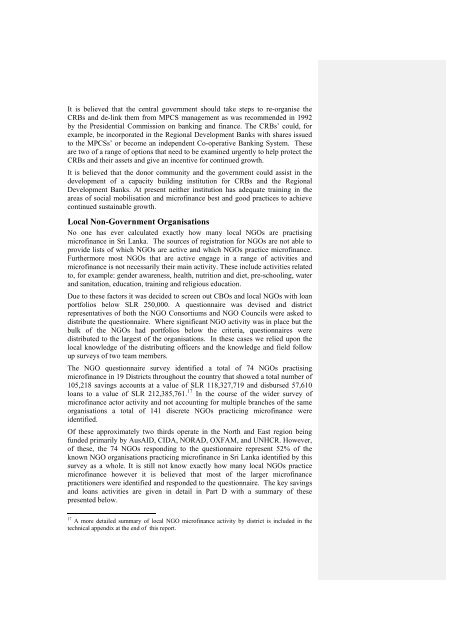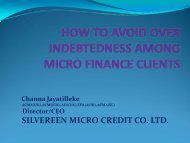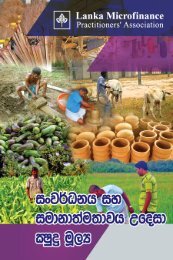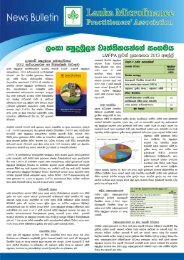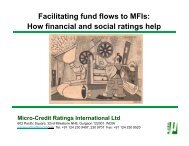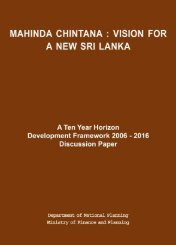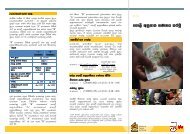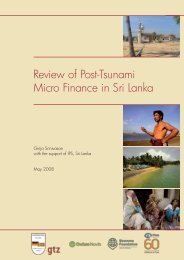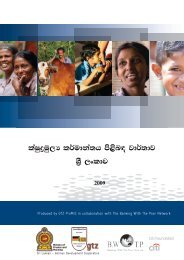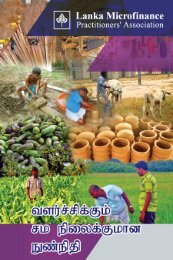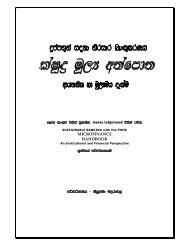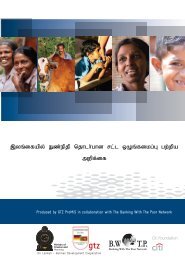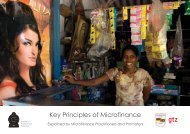National Microfinance Study of Sri Lanka: Survey of Practices and ...
National Microfinance Study of Sri Lanka: Survey of Practices and ...
National Microfinance Study of Sri Lanka: Survey of Practices and ...
Create successful ePaper yourself
Turn your PDF publications into a flip-book with our unique Google optimized e-Paper software.
It is believed that the central government should take steps to re-organise the<br />
CRBs <strong>and</strong> de-link them from MPCS management as was recommended in 1992<br />
by the Presidential Commission on banking <strong>and</strong> finance. The CRBs’ could, for<br />
example, be incorporated in the Regional Development Banks with shares issued<br />
to the MPCSs’ or become an independent Co-operative Banking System. These<br />
are two <strong>of</strong> a range <strong>of</strong> options that need to be examined urgently to help protect the<br />
CRBs <strong>and</strong> their assets <strong>and</strong> give an incentive for continued growth.<br />
It is believed that the donor community <strong>and</strong> the government could assist in the<br />
development <strong>of</strong> a capacity building institution for CRBs <strong>and</strong> the Regional<br />
Development Banks. At present neither institution has adequate training in the<br />
areas <strong>of</strong> social mobilisation <strong>and</strong> micr<strong>of</strong>inance best <strong>and</strong> good practices to achieve<br />
continued sustainable growth.<br />
Local Non-Government Organisations<br />
No one has ever calculated exactly how many local NGOs are practising<br />
micr<strong>of</strong>inance in <strong>Sri</strong> <strong>Lanka</strong>. The sources <strong>of</strong> registration for NGOs are not able to<br />
provide lists <strong>of</strong> which NGOs are active <strong>and</strong> which NGOs practice micr<strong>of</strong>inance.<br />
Furthermore most NGOs that are active engage in a range <strong>of</strong> activities <strong>and</strong><br />
micr<strong>of</strong>inance is not necessarily their main activity. These include activities related<br />
to, for example: gender awareness, health, nutrition <strong>and</strong> diet, pre-schooling, water<br />
<strong>and</strong> sanitation, education, training <strong>and</strong> religious education.<br />
Due to these factors it was decided to screen out CBOs <strong>and</strong> local NGOs with loan<br />
portfolios below SLR 250,000. A questionnaire was devised <strong>and</strong> district<br />
representatives <strong>of</strong> both the NGO Consortiums <strong>and</strong> NGO Councils were asked to<br />
distribute the questionnaire. Where significant NGO activity was in place but the<br />
bulk <strong>of</strong> the NGOs had portfolios below the criteria, questionnaires were<br />
distributed to the largest <strong>of</strong> the organisations. In these cases we relied upon the<br />
local knowledge <strong>of</strong> the distributing <strong>of</strong>ficers <strong>and</strong> the knowledge <strong>and</strong> field follow<br />
up surveys <strong>of</strong> two team members.<br />
The NGO questionnaire survey identified a total <strong>of</strong> 74 NGOs practising<br />
micr<strong>of</strong>inance in 19 Districts throughout the country that showed a total number <strong>of</strong><br />
105,218 savings accounts at a value <strong>of</strong> SLR 118,327,719 <strong>and</strong> disbursed 57,610<br />
loans to a value <strong>of</strong> SLR 212,385,761. 17 In the course <strong>of</strong> the wider survey <strong>of</strong><br />
micr<strong>of</strong>inance actor activity <strong>and</strong> not accounting for multiple branches <strong>of</strong> the same<br />
organisations a total <strong>of</strong> 141 discrete NGOs practicing micr<strong>of</strong>inance were<br />
identified.<br />
Of these approximately two thirds operate in the North <strong>and</strong> East region being<br />
funded primarily by AusAID, CIDA, NORAD, OXFAM, <strong>and</strong> UNHCR. However,<br />
<strong>of</strong> these, the 74 NGOs responding to the questionnaire represent 52% <strong>of</strong> the<br />
known NGO organisations practicing micr<strong>of</strong>inance in <strong>Sri</strong> <strong>Lanka</strong> identified by this<br />
survey as a whole. It is still not know exactly how many local NGOs practice<br />
micr<strong>of</strong>inance however it is believed that most <strong>of</strong> the larger micr<strong>of</strong>inance<br />
practitioners were identified <strong>and</strong> responded to the questionnaire. The key savings<br />
<strong>and</strong> loans activities are given in detail in Part D with a summary <strong>of</strong> these<br />
presented below.<br />
17 A more detailed summary <strong>of</strong> local NGO micr<strong>of</strong>inance activity by district is included in the<br />
technical appendix at the end <strong>of</strong> this report.


